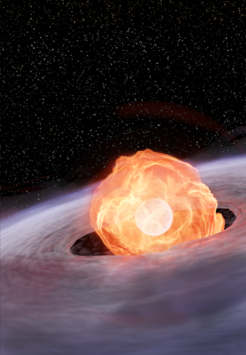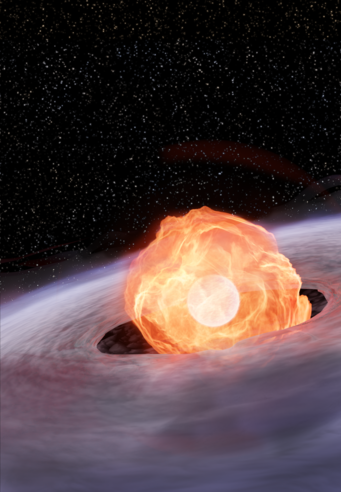Explosion observed on a White Dwarf
When stars like our Sun use up all their fuel, they shrink to form white dwarfs. Sometimes such dead stars flare back to life in a super-hot explosion, called a “nova”, and produce a fireball of X-ray radiation. Using the eROSITA telescope on the SRG space observatory, a research team led by Friedrich-Alexander-Universität Erlangen-Nürnberg (FAU) has now been able to observe such an explosion of X-ray light for the very first time.
“It was to some extent a fortunate coincidence, really,” explains Ole König from the Astronomical Institute at FAU in the Dr. Karl Remeis observatory in Bamberg, who has published an article about this observation in the reputable journal Nature, together with Prof. Dr. Jörn Wilms and a research team from the Max Planck Institute for Extraterrestrial Physics, the University of Tübingen, the Universitat Politécnica de Catalunya in Barcelona und the Leibniz Institute for Astrophysics Potsdam. “These X-ray flashes last only a few hours and are almost impossible to predict, but the observational instrument must be pointed directly at the explosion at exactly the right time,” explains the astrophysicist.

The instrument in this case is the eROSITA X-ray telescope, which is currently located one and a half million kilometers from Earth and has been surveying the sky for soft X-rays since 2019. On July 7, 2020 it measured extremely strong X-ray radiation in an area of the sky that had been completely inconspicuous four hours before. When the X-ray telescope surveyed the same position in the sky four hours later, the radiation had disappeared. It follows that the X-ray flash that had completely overexposed the center of the detector must have lasted less than eight hours.
“We were searching for strong flaring objects in the eROSITA data” says Riccardo Arcodia, who is part of the eROSITA team at the Max Planck Institute for Extraterrestrial Physics (MPE), “and this flare was so strong that at first we discussed whether it was even real. We immediately realized that we had stumbled across a unique event."
X-ray explosions such as this were predicted by theoretical research more than 30 years ago, but have never been observed directly until now. These fireballs of X-rays occur on the surface of stars that were originally comparable in size to the Sun before using up most of their fuel made of hydrogen and later helium deep inside their cores. These stellar corpses shrink until “white dwarfs” remain, which are similar to Earth in size but contain a mass that can be similar to that of our Sun.
These objects are so hot they glow white, but the radiation is so weak that it is difficult to detect from Earth. Unless the white dwarf is accompanied by a star that is still burning, that is, and when the enormous gravitational pull of the white dwarf draws hydrogen from the shell of the accompanying star.
“In time, this hydrogen can collect to form a layer only a few meters thick on the surface of the white dwarf,” explains FAU astrophysicist Jörn Wilms. In this layer, the huge gravitational pull generates enormous pressure that is so great that it causes the star to reignite. In a chain reaction, it soon comes to a huge explosion during which the layer of hydrogen is blown off. The X-ray radiation of an explosion like this is what hit the detectors of eROSITA on July 7, 2020 producing an overexposed image.
Explosion on a White Dwarf Star
“Using the model calculations we originally drew up while supporting the development of the X-ray instrument, we were able to analyze the overexposed image in more detail during a complex process to gain a behind the scenes view of an explosion of a white dwarf, or nova,” explains Jörn Wilms. According to the results, the white dwarf has around the mass of our Sun and is therefore relatively large. The explosion generated a fireball with a temperature of around 327,000 degrees, making it around sixty times hotter than the Sun.
Since these novae run out of fuel quite quickly, they cool rapidly and the X-ray radiation becomes weaker until it eventually becomes visible light, which reached Earth half a day after the eROSITA detection and was observed by optical telescopes. „A seemingly bright star then appeared, which was actually the visible light from the explosion, and so bright that it could be seen on the night sky by the naked eye,“ explains Ole König. Seemingly “new stars” such as this have been observed in the past and were named “nova stella”, or “new star” on account of their unexpected appearance. Since these novae are only visible after the X-ray flash, it is very difficult to predict such outbreaks and it is mainly down to chance when they hit the X-ray detectors. “We were really lucky,” says Ole König.
Notes to editors
eROSITA is the soft X-ray instrument aboard Spektrum-RG (SRG); it was launched into space on July 13, 2019. Its large collecting area and wide field of view are designed to perform a deep all-sky survey in the X-ray band. The joint Russian-German science mission is supported by the Russian Space Agency (Roskosmos), in the interests of the Russian Academy of Sciences represented by its Space Research Institute (IKI), and the German Space Agency at DLR (Deutsches Zentrum für Luft- und Raumfahrt). The SRG spacecraft was built by Lavochkin Association (NPOL) and its subcontractors, and is operated by NPOL with support from the Max-Planck Institute for Extraterrestrial Physics (MPE).
The development and construction of the eROSITA X-ray instrument was led by the Max Planck Institute for Extraterrestrial Physics (MPE), with contributions from the Dr. Karl Remeis Observatory Bamberg, the University of Hamburg Observatory, the Leibniz Institute for Astrophysics Potsdam (AIP), and the Institute for Astronomy and Astrophysics of the University of Tübingen, with the support of DLR and the Max Planck Society. The Argelander Institute for Astronomy of the University of Bonn and the Ludwig-Maximilians-Universität Munich also participated in the science preparation for eROSITA. The eROSITA data are processed using the eSASS software system developed by the German eROSITA consortium.












